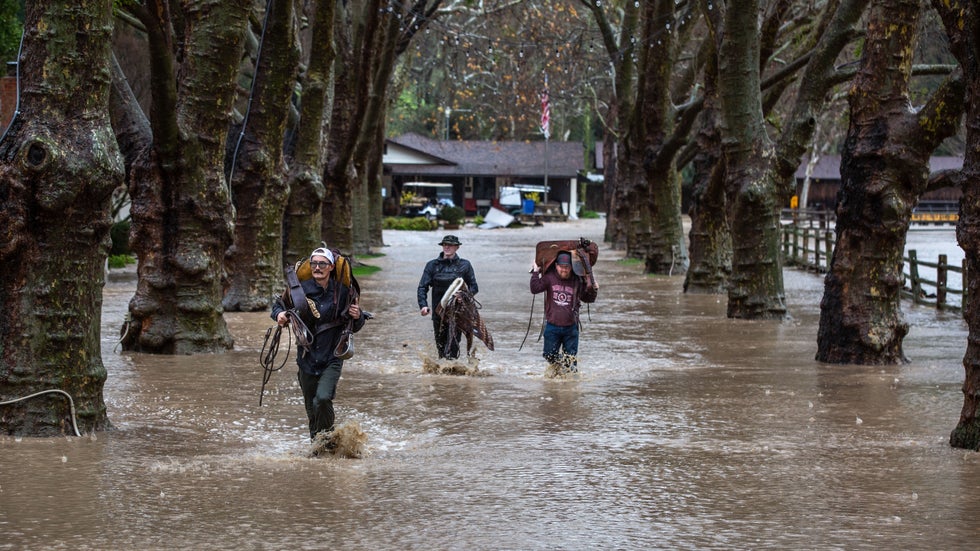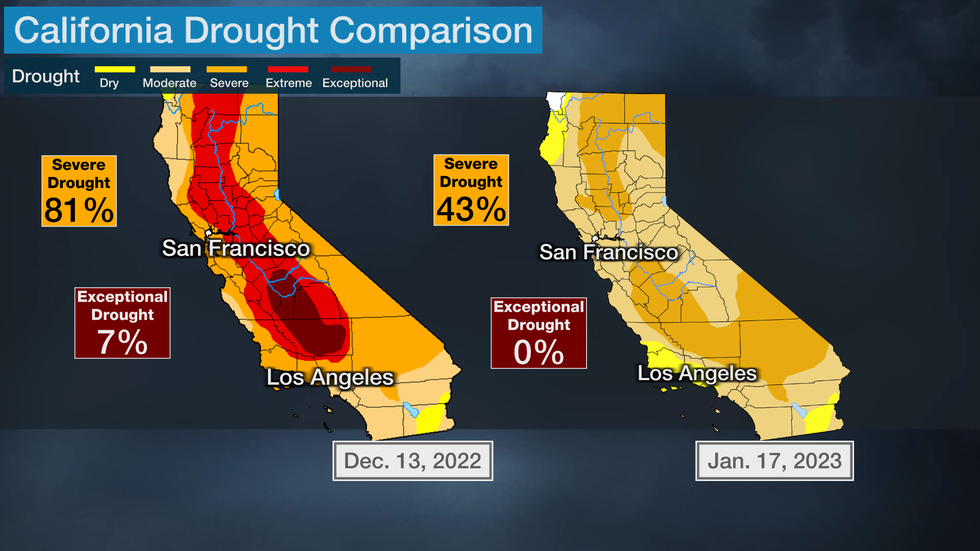Jan Wesner Childs
Sign up for the Morning Brief email newsletter to get weekday updates from The Weather Channel and our meteorologists.
In less than a month, parts of California saw nearly 4 feet of rain. Higher elevations received between 15 and 20 feet of snow.
But was it enough to end the state's seemingly relentless drought?
"We will likely need multiple above-average seasons of precipitation before we can discuss the complete end to the drought," Andrew Schwartz, lead scientist and manager of UC Berkeley's Central Sierra Snow Laboratory, said in an email Thursday. "We have had too little precipitation over the last several years for one storm or one good season to completely alleviate it."
(MORE: California Storm Siege A Stunning Reversal From Recent Winters)
Winter is California's wet season, and it's not just rain that's important. The state relies on spring snowmelt to provide 30% of its freshwater supply, Schwartz said.
"Every bit above average helps when we get to April, so we're crossing our fingers for big snowfall numbers until then," Schwartz said.
The California Department of Water Resources considers April 1 a key date in drought indicators. That's when snowpack is typically at its peak.
"These storms have not ended the drought," department spokesperson Mary Fahey said in an email Thursday.
Fahey points to reasons for "cautious optimism," but a return to dry weather could wipe out recent gains.
"As an example, we ended 2021 with above-average snow for that time of year," she said. "But it disappeared following the driest January through March on record."
 Alisal Ranch and Resort, a favorite hideaway of Hollywood celebrities, is seen amid flooding on Jan. 9, 2023, in Solvang, California.
Alisal Ranch and Resort, a favorite hideaway of Hollywood celebrities, is seen amid flooding on Jan. 9, 2023, in Solvang, California.Could Snowfall End The Drought This Year?
Schwartz says there is no "golden amount" of precipitation that would end the drought. That's because water systems are complex and vary greatly over the vastness of a state like California, as do drought conditions.
(MORE: California Storm Parade Produces Record Mid-January Sierra Snowpack)
But he offers up some context for the site of the snow lab, which has been tracking conditions at Donner Pass, California, since 1946.
"It was suggested earlier this year that California is now a full year behind in our precipitation. If that's true, based solely on the snow lab, we would need to see approximately an additional 30 feet of snow on top of our 30-foot seasonal average for that to happen," Schwartz said. "Getting 60 feet of snow in a year isn't impossible but it is unlikely, so we'd likely need to spread that 30 extra feet over several years and that could, realistically, take anywhere between two to five years if conditions are favorable."
Current California Drought Conditions
The storms have brought some relief – for now. On Dec. 13, 81% of California was considered to be in severe drought. That number was nearly cut in half by Jan. 17, according to the latest U.S. Drought Monitor report. And areas of exceptional drought disappeared completely.
The report notes: "Historically, long-term drought is interrupted by a period of abnormally wet weather. However, it’s too early to tell if the wet weather is enough to end the drought."

The Drought Outlook
The drought monitor predicts continued improvement for many areas in the short term.
Through April, some improvement or even the eradication of drought could occur in Northern California. Southern parts of the state are predicted to see drought persist.

Storms Brought Record Rainfall
On average, 11.47 inches of precipitation fell over the entire state during the siege of storms. The highest total – nearly 4 feet – was in the Honeydew community in Northern California's Humboldt County. Cities including Oakland, San Francisco and Stockton all set rainfall records for the 23-day period.
"This additional snow and strong start to the season is terrific, but we need the storm window to remain open to see further snowfall and increase our snowpack before we can talk about significant impacts to the drought," Schwartz said.
The storms were fueled by a series of atmospheric rivers, which are plumes of moisture above the Earth. While the precipitation they bring is often much-needed, it can also be deadly. At least 19 deaths are being connected to the storms in California, and one in the state of Washington.
Flooding and mudslides destroyed roads and other infrastructure, and the financial toll of the storms is still being tallied.
"Honestly, because this has been so ongoing and there’s so many parts of the state that they haven’t actually been able to access yet because there’s still significant road closures across the state ... several hundred million, (are) the initial estimates, but I expect that number to go up," said Deanne Criswell, head of the Federal Emergency Management Agency, while en route to tour storm damage with President Joe Biden on Thursday.
Water Supplies Aren't Fully Replenished
Some of California's reservoirs were pushed to record-low water levels in recent years and still sit below average.
But the reservoirs, like snowpack and rainfall, are only part of the complex water puzzle.
"California's groundwater basins provide more than eight to 12 times more storage than all of our surface water reservoirs combined," Fahey said. "These basins have been utilized heavily over these last three years of drought and past droughts in California."
(MORE: Biden Visits Storm-Torn California)
The increase in groundwater pumping during the drought depleted those underground stores.
"Even with all of this recent rain, most groundwater levels are not back to pre-drought levels," Fahey said.
State agencies, including the Department of Water Resources, are working to streamline regulatory steps to allow local communities to divert excess water – like what fell in recent weeks – to recharge depleted groundwater basins.
A permit was recently issued for a pilot project in Merced County.
The Role Of Climate Change
Drought and heat are both examples of the cumulative effects of climate change.
"As temperatures increase, warm-season phenomena like drought, wildfires and heat waves are expected to be worsened, both in intensity and in longevity. The increase in temperatures will dry out the ground and its flora, which will slowly lead to a positive feedback cycle of warmer temperatures, then less rainfall, then warmer temperatures and so forth," weather.com meteorologist Jonathan Belles said in an article on 2022's worst weather disasters.
Recent years of historic drought have coincided with record wildfires in California, which in turn deplete soil moisture even more.
"California has always been a land of extremes, but we're seeing climate change amplify those extremes," said Schwartz.
 Lake Oroville, California's second-largest water reservoir, is seen at 40% on Aug. 9, 2022, near Oroville, California.
Lake Oroville, California's second-largest water reservoir, is seen at 40% on Aug. 9, 2022, near Oroville, California.The Weather Company’s primary journalistic mission is to report on breaking weather news, the environment and the importance of science to our lives. This story does not necessarily represent the position of our parent company, IBM.
The Weather Company’s primary journalistic mission is to report on breaking weather news, the environment and the importance of science to our lives. This story does not necessarily represent the position of our parent company, IBM.

No comments:
Post a Comment